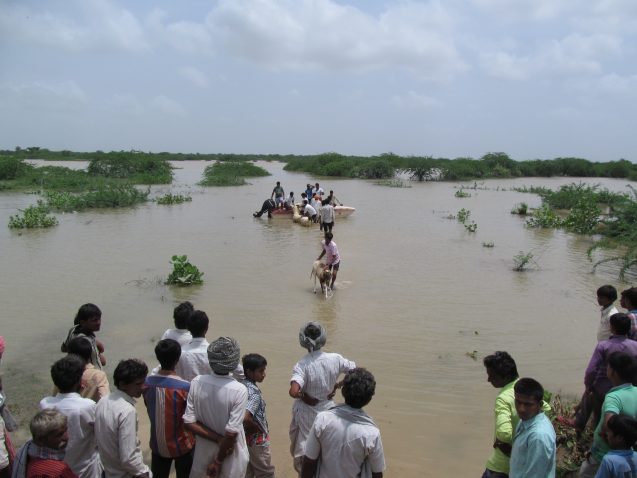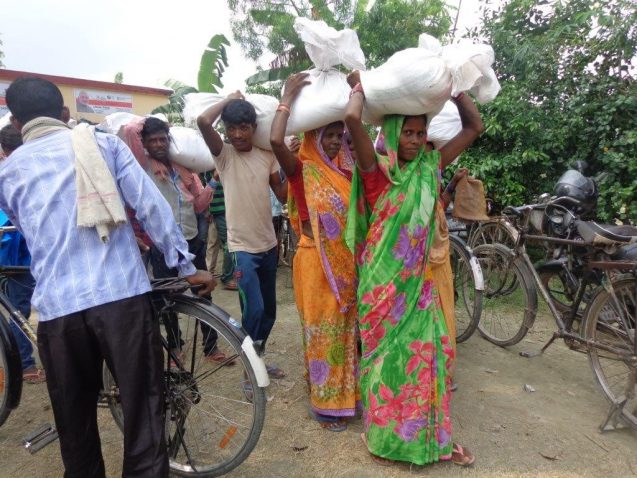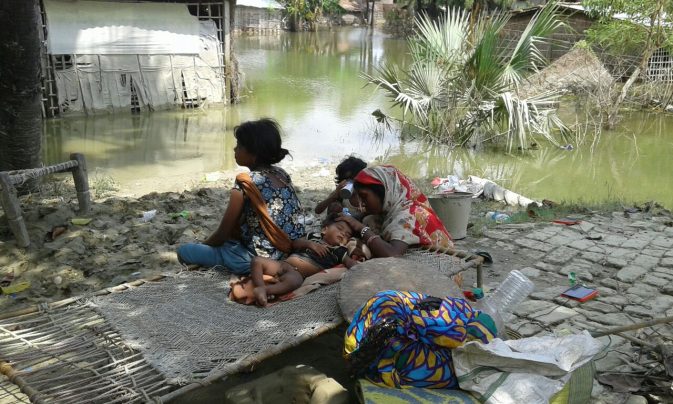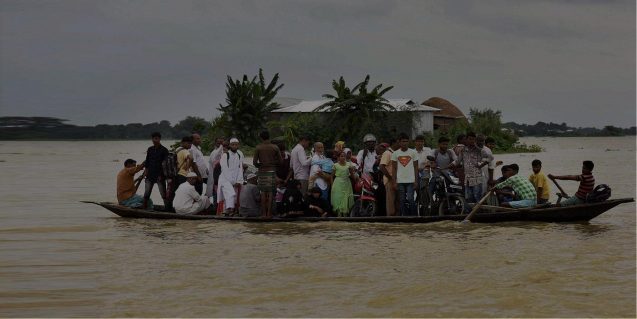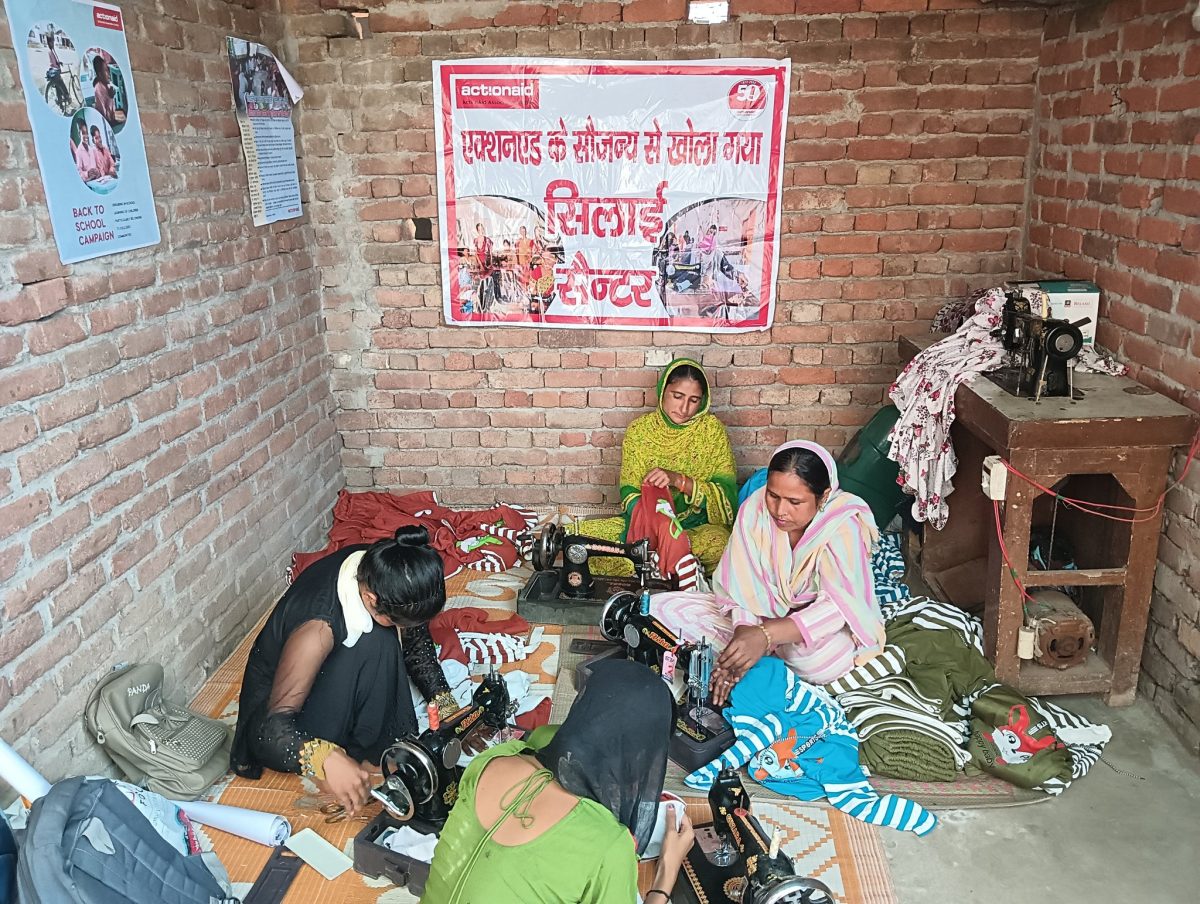Assam is currently experiencing the most severe flooding seen in the state in over 30 years. To date, more than
3.3 million people have been affected in 3186 villages across 25 districts. Action Aid India is on the ground in Guwahati and other areas in Assam providing critical assistance, but
additional resources are urgently needed to ensure that populations affected by the flooding can make a full and speedy recovery.
Impact of Floods
Since the beginning of July, Assam has been struck by two waves of flooding that have taken an enormous toll on communities throughout the state. The first wave of flooding was preceded by incessant rainfall caused by the combination of an early monsoon and the effects of Cyclone Mora. The floods reached their peak around July 13
th-14
th, at which point more than
1.7 million people were affected across 16 districts in the state. Though the statewide water level began to recede for a few days at the end of July temporarily allowing people to return to their homes, Assam was struck again by another round of deadly floods in August, the effects of which are still being dealt with today.
Recent estimates suggest that the current episode of flooding in August has
killed at least 180 people in Assam alone and
displaced hundreds of thousands more from their homes in districts such as Morigaon, North Lakhimpur, Dhemaji, South Salmara, Barpeta, Kokrajhar and Dhubri. Flooding has additionally had a number of other consequences, including
damaging/destroying countless houses and other buildings, and
affecting 182,343 hectares of cropland, which has proven to be particularly problematic for the large portion of the Assamese population who are farmers and rely on agriculture for their economic livelihood. As a result of flooding, many people across Assam have moreover been left with
insufficient access to food and clean water and currently face an
elevated risk of diseases like malaria, cholera, and diarrhea in submerged areas.
Government Response
To date, government actors have responded to the crisis in Assam by:
- Organizing search and rescue operations that have involved Indian Army troops, and both National and State Disaster Relief Forces. These operations have saved more than 3000 lives.
- Constructing relief camps throughout the state, where up to 138,648 people have taken shelter in 304 different locations.
- Distributing emergency dry food rations to individuals and families in relief camps.
- Providing non-food items (NFIs) such as water purification tablets, tarpaulins, candles, mosquito coils, etc. These goods have helped address some of the vulnerabilities faced by flood-affected communities but have been unevenly distributed and insufficient in quantity.
Action Aid’s Intervention Thus Far
(As on August 30, 2017)
Along with local partner organizations including SSTEP, NEADS and NERSWN, Action Aid India has been taking an active role in the overall emergency response and has reached more than 2200 families in flood-affected areas of Assam. To date, our relief efforts in Morigaon district especially have included:
- Distributing pre-cooked food and dry rations including rice, lentils, salt, and cooking oil (600 families)
- Providing tarpaulin sheets for the construction of temporary shelters (600 families)
- Supplying essential WASH items like hygiene kits and bleaching powder to limit the spread of disease (300 families)
- Giving NFIs including dignity kits and to women and other affected groups (600 families)
- Providing basic healthcare to people and communities in need (300 families)
Action Aid India has also been working tirelessly to help promote longer term rehabilitation of affected populations. These efforts have included:
- Initiating cash-for-work programs to ensure that families that have been impacted by flooding have access to a stable source of income
- Providing livelihood support to families in the form of seeds and other supplies
- Supporting female-headed households with financial assistance
What are the Relief Requirements?
Given the immense scale of flooding in Assam, there are still significant vulnerabilities among affected communities need to be addressed. The following requirements have been identified by Action Aid and local partner organizations as being of immediate importance:
| Food Security |
Additional food aid is required to meet the needs of flood-affected communities. The government and NGOs have been distributing rations to families, but not enough has reached those in need and groups like women and children remain vulnerable. |
| WASH |
More water purification tablets are needed to ensure that communities have access to clean water for drinking and other uses. The lack of a safe and reliable water supply in many affected areas of Assam has caused some people to turn to drinking flood water, which poses a health hazard. |
| Shelter |
Tarpaulins are required to help families affected by the floods construct temporary shelters. Though some shelter camps have been established, they do not have enough space to meet the shelter needs of the entire affected population. |
| NFIs |
Hygeine kits are needed to reduce the health risks caused by flooding and help crisis-afflicted communities live with dignity under the harsh conditions they face. |
| Livelihoods |
Farmers require fodder for livestock and seeds/paddy sapplings to help them recover from the damage flooding has caused to their livelihoods. |
Considering the needs of people in flood-affected areas, Action Aid and its local partners have developed plans to target villages in two blocks that have been hit particularly hard by the emergency: Chariali in Biswanath Chariali District and Lahorighat in Morigaon District.
| Affected villages and estimated number of affected families |
| District: Biswanath Chariali |
| Block: Chaiduar |
| Sl.No |
Name of Village |
Gaon Panchayat |
Affected families/people (based on estimates from local people) |
| 1 |
Gopal Jarani |
Bakori doloni |
270 |
| 2 |
Low-Khoti |
Bakori doloni |
310 |
| 3 |
Thotachapori |
Bakori doloni |
193 |
| 4 |
Bordoloni |
Kalyanpur |
280 |
| 5 |
Datkola |
Kalyanpur |
390 |
| 6 |
Bakari Doloni |
Bakoro Doloni |
409 |
| 7 |
Galcheppa |
Krishnapur/Rangaliyal |
500 |
| 8 |
Jakapara |
Rangaliyal |
570 |
| 9 |
Akhoiphuta |
Rangaliyal |
393 |
| Total |
|
|
3315 |
| District: Morigaon |
| Block: Lahorighat |
| Sl.No |
Name of Village |
Gaon Panchayat |
Affected families/people (based on estimates from local people) |
| 1 |
Kathani |
Kathani |
250 |
| 2 |
Mikirgaon |
Tulsibari |
270 |
| 3 |
Tulsibori |
Tulsibari |
200 |
| 4 |
Jatiabori |
Tulsibari |
245 |
| 5 |
Batabori |
Dupguri |
320 |
| 6 |
Tengaguri |
Tengaguri |
265 |
| 7 |
Tinsukia |
Dupguri |
400 |
| 8 |
Mohmara |
Dupguri |
150 |
| Total |
|
|
2100 |
Indicative Budget to reach about 1700 families would be as under:
| Relief Support |
|
Items/particulars |
Unit |
Quantity |
Rate |
Amount |
| 1.) |
Food aid (1700 families) |
|
|
|
1334500 |
| A |
Rice (20 kg. Per family) |
kg. |
34000 |
30 |
1020000 |
| B |
Lentils (Masur Dal) (1 kg. Per family) |
kg. |
1700 |
60 |
102000 |
| C |
Cooking Oil (Mustard Oil) (1 lts. per family) |
lt. |
1700 |
110 |
187000 |
| D |
Salt (1 kg. Per family) |
kg. |
1700 |
15 |
25500 |
| 2.) |
WASH |
|
|
|
1376150 |
| A |
Bleaching powder |
kg. |
850 |
19 |
16150 |
| B |
Hygiene Kit |
Pkt |
1700 |
800 |
1360000 |
| 3.) |
Shelter |
|
|
|
120000 |
| A |
Tarpaulin sheets |
Pcs |
200 |
600 |
120000 |
| Rehabilitation supports |
| 4.) |
Livelihoods support |
|
|
|
486000 |
| A |
Seeds(Mustard and Pulses) |
Kg |
2800 |
120 |
336000 |
| B |
Seeds (rabi crop) |
seed kit |
500 |
300 |
150000 |
| 5.) |
Cash for work (shelter repairing) |
|
|
|
525000 |
| A |
House repairing under cash for work (300 families for 7 days)) |
days |
2100 |
250 |
525000 |
| 6.) |
Support to women headed households |
|
|
|
225000 |
|
Support to women headed households |
person |
75 |
3000 |
225000 |
| Communication, logistics and HR |
| 7.) |
Communication and awareness |
|
|
|
35000 |
| 1 |
Meetings |
Lumpsum |
1 |
15000 |
15000 |
| 2 |
Visibility materials /printing/stationary |
Lumpsum |
1 |
20000 |
20000 |
| 8.) |
Logistics |
|
|
|
110000 |
| 1 |
Relief material transportation |
Lumpsum |
1 |
50000 |
50000 |
| 2 |
Travel |
Lumpsum |
1 |
40000 |
40000 |
| 3 |
Cost for management of relief distribution |
1 |
1 |
20000 |
20000 |
| 9.) |
Salaries and honorariums |
|
|
|
98000 |
| 1 |
Project coordinator (1 person for 2 months) |
months |
2 |
14000 |
28000 |
| 2 |
Volunteers (7 persons for 2 months) |
months |
14 |
5000 |
70000 |
|
|
|
|
|
|
|
Total |
|
INR |
|
4309650 |
